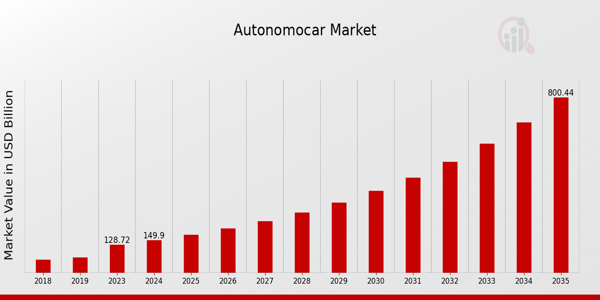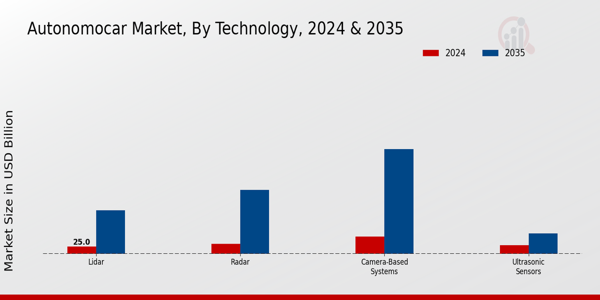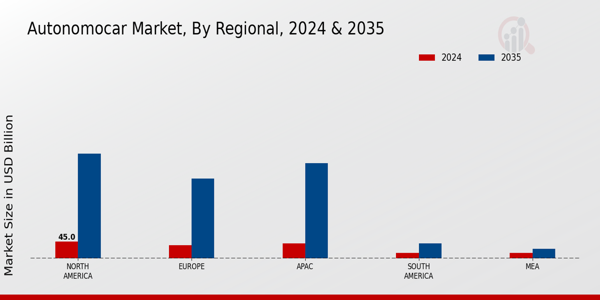Autonomocar Market Overview:
As per MRFR analysis, the Autonomocar Market Size was estimated at 128.72 (USD Billion) in 2023.The Autonomocar Market is expected to grow from 149.9 (USD Billion) in 2024 to 800.0 (USD Billion) by 2035. The Autonomocar Market CAGR (growth rate) is expected to be around 16.45% during the forecast period (2025 - 2035).
Key Autonomocar Market Trends Highlighted
Numerous important variables are propelling the global autonomous car market. One important factor is the growing demand for efficiency and safety in transportation. The capabilities of autonomous vehicles are improved by technological developments in artificial intelligence and machine learning, which increases their consumer appeal.
Additionally, governments and manufacturers are being pushed to invest in autonomous technologies by the growing need to lessen environmental effects and traffic congestion.
Additionally, regulatory support is growing, creating a more hospitable environment for these vehicles' testing and deployment. In this dynamic industry, there are a lot of opportunities just waiting to be discovered.
Investments in infrastructure to support autonomous vehicles, such as smart traffic management systems and charging stations, can create new business avenues. Collaborations between tech companies and traditional automotive manufacturers present opportunities for innovation and product development.
Additionally, the rising interest in electrification and sustainability within the automotive sector offers a chance to integrate green technology into autonomous systems, making them even more attractive to consumers.
Recent times have shown noteworthy trends in the Global Autonomocar Market. Companies are increasingly focusing on Level 4 and Level 5 automation, which allows for higher degrees of autonomy.
The development of connected vehicles that communicate with each other and with their surroundings is gaining momentum, enhancing safety and efficiency. Consumer sentiment is gradually shifting, with more people open to the idea of sharing autonomous vehicles.
As public awareness grows, so does interest in autonomous ride-sharing services, which could redefine urban mobility. Long-term partnerships and strategic alliances among tech firms and automotive manufacturers are becoming commonplace, ensuring that advancements in automation keep pace with consumer expectations and regulatory changes.

Source: Primary Research, Secondary Research, MRFR Database and Analyst Review
Autonomocar Market Drivers
Technological Advancements in AI and Machine Learning
The Global Autonomocar Market is experiencing an unprecedented wave of technological advancements, particularly in artificial intelligence (AI) and machine learning.
These innovations are crucial for improving the capabilities of autonomous vehicles, enabling them to analyze vast amounts of data from their surroundings, recognize patterns, and make informed driving decisions in real-time. Cutting-edge sensors, sophisticated algorithms, and enhanced processing power are converging to create a more reliable and efficient automotive experience.
As these technologies evolve, vehicles are expected to become safer and more adept at navigating complex driving environments, including urban settings, highways, and adverse weather conditions. The increasing demand for smart and connected vehicles is further fueling this technological revolution as consumers seek features that provide convenience, safety, and improved driving experiences.
Furthermore, the growing investments from major automotive manufacturers, tech companies, and startups into research and development initiatives are propelling the Global Autonomocar Market forward.
This convergence of technology and automotive manufacturing is leading to a faster rollout of autonomous systems and is serving as a significant driver for market growth, positioning autonomous vehicles as the future of transportation.
Government Initiatives and Regulation
Government initiatives and regulatory frameworks play a pivotal role in shaping the Global Autonomocar Market. Many governments around the world are actively promoting the development and integration of autonomous vehicles through favorable policies, safety guidelines, and funding for research projects.
These regulations help establish a clear pathway for companies to operate and innovate while ensuring public safety. Additionally, government investments in smart transportation infrastructure, such as connected traffic systems and intelligent transportation networks, are further enhancing the operational efficiency of autonomous vehicles.
As legislative support increases, more automotive manufacturers are likely to enter the market or accelerate their existing projects, resulting in substantial growth and innovation within the industry.
Rising Demand for Enhanced Safety Features
Safety remains a foremost consideration among consumers, and the demand for enhanced safety features is driving the evolution of the Global Autonomocar Market.
Autonomous vehicles are designed to minimize human error, which is responsible for a significant percentage of road accidents. As a result, features like advanced driver assistance systems (ADAS), collision avoidance, and emergency braking systems are becoming standard in autonomous vehicles.
This heightened focus on safety, coupled with consumer awareness and demand for safer transportation options, is furthering the growth of the market as manufacturers prioritize the development of secure, reliable, and technologically advanced vehicles.
Autonomocar Market Segment Insights:
Autonomocar Market Technology Insights
The growth trend showcased the increasing reliance on innovative technologies to enhance vehicular autonomy.
Among the technological aspects, Camera-based Systems emerged as a dominant force, holding significant market valuation of 60.0 USD Billion in 2024, and expected to soar to 360.0 USD Billion by 2035. This growth can be attributed to their extensive application in object detection, lane-keeping, and real-time image processing, which are crucial for a seamless autonomous driving experience.
Similarly, the technology segment highlighted the importance of Radar systems, which hold a substantial value of 35.0 USD Billion in 2024 and are projected to reach 220.0 USD Billion by 2035. Radar technology's capability to function in various weather conditions while providing accurate distance measurement contributes to its expanding significance in the market.
In addition, Lidar technology gained prominence, with market valuations of 25.0 USD Billion in 2024, increasing to 150.0 USD Billion by 2035, owing to its precision in generating high-resolution maps and identifying obstacles.
Additionally, Ultrasonic Sensors, valued at 29.9 USD Billion in 2024 with expectations to rise to 70.0 USD Billion by 2035, played a critical role in short-range detection and parking assistance, thus underlining their relevance in the overall technological framework of autonomous vehicles.
The interplay among these technologies not only drives the Global Autonomocar Market segmentation but also presents an array of challenges such as the need for standardization and integration issues, alongside opportunities for enhanced safety features and improved user experience in autonomous driving.
These insights underscore the critical role of technology in shaping the future landscape of autonomy in the automotive industry.

Source: Primary Research, Secondary Research, MRFR Database and Analyst Review
Autonomocar Market Autonomous Level Insights
The Global Autonomocar Market has been experiencing significant momentum, particularly within the Autonomous Level segment, which reflects a remarkable evolution in transportation technology.
The market consists of several categories, including Level 1 through Level 5, each representing increasing degrees of vehicle automation. Level 1 and Level 2 tend to focus on driver assistance features, making them crucial for initial adoption and creating consumer awareness.
In contrast, Levels 3 to 5 represent substantial technological breakthroughs, with Level 5 aimed at fully autonomous vehicles, positioning itself as a critical frontier for industry players. The progress in sensor technology and AI development fuels optimism across the sector as the demand for enhanced safety and convenience continues to drive the market's evolution.
With the increasing push towards electric and sustainable transport solutions, the Global Autonomocar Market segmentation points to rising opportunities that the industry can capitalize on. Statistics indicate that consumer acceptance and regulatory frameworks will play significant roles in shaping the future landscape of autonomous vehicles.
Autonomocar Market Vehicle Type Insights Within this expansive market, the differentiation among vehicle types plays a crucial role in shaping market dynamics. The vehicle categoriesincluding Passenger Vehicles, Commercial Vehicles, Public Transportation, and Two Wheelerseach exhibit unique characteristics that contribute to the overall market growth.
Passenger Vehicles dominate the market, primarily due to increasing consumer demand for personal mobility solutions and advancements in autonomous technologies enhancing safety and convenience.
Commercial Vehicles also play a significant part, as the need for automation in freight and logistics operations continues to rise, optimizing efficiency and reducing operational costs. Public Transportation is gaining traction as cities worldwide focus on sustainable and efficient mass transit solutions, fostering the development of autonomous buses and shuttles.
Two Wheelers, although encompassing a smaller yet growing segment, represent an emerging area of interest, especially in densely populated urban environments where space and traffic congestion are major concerns.
The Global Autonomocar Market revenue is bolstered by these diverse vehicle types, reflecting a shift towards smarter, safer, and more efficient transportation solutions in urban landscapes.
Autonomocar Market End Use Insights As the market evolves, it is essential to understand the significance and impact of its diverse applications including Personal Use, Ride Sharing, and Public Transportation.
Personal Use stands as a critical area, reflecting growing consumer demand for convenience and safety, thus contributing significantly to overall market dynamics. Ride Sharing continues to gain traction as urban mobility shifts towards shared solutions, offering flexibility while reducing the carbon footprint.
Meanwhile, Public Transportation is increasingly integrating autonomous technologies, enhancing efficiency and accessibility, which is crucial in accommodating urban population growth.
The Global Autonomocar Market revenue is being strongly fueled by technological advancements, evolving consumer preferences, and supportive regulations, creating a favorable environment for these End Use applications to thrive and reshape future mobility landscapes.
Market growth is also influenced by a growing emphasis on sustainability and reduced congestion in urban areas, paving the way for advanced autonomous vehicle implementations across these segments.
Autonomocar Market System Type Insights Within this expansive market, the System Type segment plays a crucial role in defining the operational efficiency and capability of autonomous vehicles.
This segment encompasses essential components such as Hardware, Software, and Data Services, each contributing uniquely to the market landscape. The Hardware segment is fundamental as it includes critical physical systems necessary for vehicle operation, equipped with sensors and computing units.
The Software element is equally significant, providing the intelligence required for navigation, control, and decision-making processes in autonomous driving. Data Services are indispensable, facilitating real-time information exchange and analytics to improve driving performance and safety.
Collectively, these components drive technological advancements and address challenges in safety and efficiency, positioning the Global Autonomocar Market for robust growth by attracting investments and supporting innovations.
As the market evolves, these System Type components stand out due to their increasing importance in the functionality and reliability of autonomous vehicles, thus highlighting their integral role in the Global Autonomocar Market revenue.
Autonomocar Market Regional Insights
The Global Autonomocar Market experienced significant growth across various regions, with North America leading with a valuation of 45.0 USD Billion in 2024, anticipated to soar to 275.0 USD Billion by 2035, reflecting its dominance in technology adoption and investment.
Europe followed closely, starting at 35.0 USD Billion in 2024 and projected to reach 210.0 USD Billion by 2035, supported by strong regulatory frameworks and a focus on sustainability. APAC, valued at 40.0 USD Billion in 2024, is expected to grow to 250.0 USD Billion, driven largely by rapid urbanization and advancements in technological infrastructure.
In contrast, South America, with a smaller valuation of 15.0 USD Billion in 2024 growing to 40.0 USD Billion, was at a developing stage due to economic factors and infrastructure challenges, while the MEA region lagged slightly behind at 14.9 USD Billion in 2024 with a projected rise to 25.0 USD Billion, focusing on expanding mobility solutions.
Together, these regions presented diverse opportunities, with North America and Europe holding a majority share, driven by innovation, whereas APAC exhibits strong growth potential, showcasing the varied landscape of the Global Autonomocar Market.

Source: Primary Research, Secondary Research, MRFR Database and Analyst Review
Autonomocar Market Key Players and Competitive Insights:
The Global Autonomocar Market is rapidly evolving, characterized by significant technological advancements and increasing investments from major stakeholders. This market comprises various players, from automotive manufacturers to tech startups, all competing to establish their foothold in this innovative sector.
Competitive insights reveal that companies are focusing on enhancing their autonomous driving capabilities through the integration of artificial intelligence, machine learning, and advanced sensor technologies.
The race for market dominance is intense, with strategic collaborations and partnerships being key drivers for innovation. As consumer demand for safer and more efficient transportation solutions grows, understanding the competitive landscape becomes crucial for companies aiming to thrive in this transformative space.
Zoox has emerged as a notable player in the Global Autonomocar Market, leveraging its unique approach to autonomous vehicle development. The company is positioned as a forefront innovator with a strong emphasis on designing vehicles that are purpose-built for autonomy rather than retrofitting existing models.
This strategic focus allows Zoox to create a seamless user experience, enhancing mobility options for passengers. With a dedicated research and development framework, the company has cultivated significant strengths in engineering advanced robotic technology and artificial intelligence, enabling superior navigation and obstacle avoidance capabilities.
On the operational side, Zoox's commitment to sustainability demonstrates its alignment with broader industry trends toward environmentally friendly solutions, enhancing its appeal in a competitive market.
Cruise, another influential contender in the Global Autonomocar Market, has built a robust reputation for its dedication to creating safe and reliable autonomous vehicles.
Supported by substantial investments, the company focuses on scaling its technology to deliver real-world applications effectively. Cruise's strengths lie in its strong backing from its parent company, which provides significant resources and expertise.
This backing not only enhances its operational capabilities but also fosters trust in its technological advancements. Additionally, Cruise has established strategic partnerships with various cities and regulatory bodies, allowing it to navigate complex regulatory landscapes more effectively.
By concentrating on urban mobility and collaborating with ride-sharing platforms, Cruise demonstrates a keen understanding of market demands and consumer preferences, positioning itself for long-term success in the competitive landscape of the autonomocar sector.
Key Companies in the Autonomocar Market Include:
- Zoox
- Cruise
- Pony.ai
- Ford
- General Motors
- Toyota
- Tesla
- Aurora
- BMW
- Honda
- Nuro
- Nissan
- Baidu
- Waymo
- Mobileye
Autonomocar Market Developments
Zoox is ramping up its R&D efforts, focusing on developing a fully autonomous vehicle for urban environments, with significant funding flowing into the startup ecosystem. Cruise continues to expand its autonomous ride-hailing services in various U.S. cities, while Pony.ai is making strides in integrating its technology with fleet vehicles across multiple regions.
Ford and General Motors are investing heavily in autonomous vehicle tech, with GM's Cruise division announcing partnerships with major tech firms to enhance its software capabilities. Toyota is collaborating with Aurora to advance its self-driving platforms, aiming for commercialization in the near future.
Tesla remains a frontrunner, with continuous software updates enhancing its Full Self-Driving capabilities, leading to increased market attention. Meanwhile, BMW and Honda are exploring joint projects in autonomous driving technology, further intensifying competitive pressure.
Nuro has made advancements in last-mile delivery with its autonomous vehicle deployments, while Nissan is looking to expand its footprint in the sensor technology space. Baidu's Apollo project is also gaining momentum, showcasing significant innovations in self-driving algorithms.
Waymo continues to be a benchmark for autonomous taxi services, leveraging its extensive data collected from urban environments to refine operations. Mobileye is emerging strongly with its new autonomous driving software, offering advanced safety features.
Autonomocar Market Segmentation Insights
Autonomocar MarketTechnologyOutlook
- Lidar
- Radar
- Camera-based Systems
- Ultrasonic Sensors
Autonomocar MarketAutonomous LevelOutlook
- Level 1
- Level 2
- Level 3
- Level 4
- Level 5
Autonomocar MarketVehicle TypeOutlook
- Passenger Vehicles
- Commercial Vehicles
- Public Transportation
- Two Wheelers
Autonomocar MarketEnd UseOutlook
- Personal Use
- Ride Sharing
- Public Transportation
Autonomocar MarketSystem TypeOutlook
- Hardware
- Software
- Data Services
Autonomocar MarketRegionalOutlook
- North America
- Europe
- South America
- Asia Pacific
- Middle East and Africa
| Attribute/Metric Source: |
Details |
| MARKET SIZE 2023 |
128.72(USD Billion) |
| MARKET SIZE 2024 |
149.9(USD Billion) |
| MARKET SIZE 2035 |
800.0(USD Billion) |
| COMPOUND ANNUAL GROWTH RATE (CAGR) |
16.45% (2025 - 2035) |
| REPORT COVERAGE |
Revenue Forecast, Competitive Landscape, Growth Factors, and Trends |
| BASE YEAR |
2024 |
| MARKET FORECAST PERIOD |
2025 - 2035 |
| HISTORICAL DATA |
2019 - 2024 |
| MARKET FORECAST UNITS |
USD Billion |
| KEY COMPANIES PROFILED |
Zoox, Cruise, Pony.ai, Ford, General Motors, Toyota, Tesla, Aurora, BMW, Honda, Nuro, Nissan, Baidu, Waymo, Mobileye |
| SEGMENTS COVERED |
Technology, Autonomous Level, Vehicle Type, End Use, System Type, Regional |
| KEY MARKET OPPORTUNITIES |
AI integration for enhanced safety, Government regulations favoring autonomous vehicles, Increased demand for urban mobility solutions, Partnerships with tech startups, Advancements in battery technology for EVs |
| KEY MARKET DYNAMICS |
Technological advancements, Regulatory frameworks, Consumer acceptance, Infrastructure readiness, Competitive landscape |
| COUNTRIES COVERED |
North America, Europe, APAC, South America, MEA |
Frequently Asked Questions (FAQ) :
The Global Autonomocar Market is expected to be valued at 149.9 USD Billion in 2024.
The market is projected to grow at a CAGR of 16.45% from 2025 to 2035.
By 2035, the Global Autonomocar Market is expected to be valued at 800.0 USD Billion.
North America is anticipated to dominate with a market valuation of 275.0 USD Billion by 2035.
The Lidar technology segment is expected to be valued at 25.0 USD Billion in 2024 and 150.0 USD Billion in 2035.
The Camera-based Systems segment is projected to reach a market value of 360.0 USD Billion by 2035.
The Radar technology segment is expected to be valued at 35.0 USD Billion in 2024 and 220.0 USD Billion in 2035.
Major players include Zoox, Cruise, Ford, General Motors, Toyota, and Tesla among others.
The APAC region is valued at 40.0 USD Billion in 2024 and is expected to reach 250.0 USD Billion by 2035.
The Ultrasonic Sensors segment is expected to be valued at 29.9 USD Billion in 2024 and 70.0 USD Billion in 2035.
















